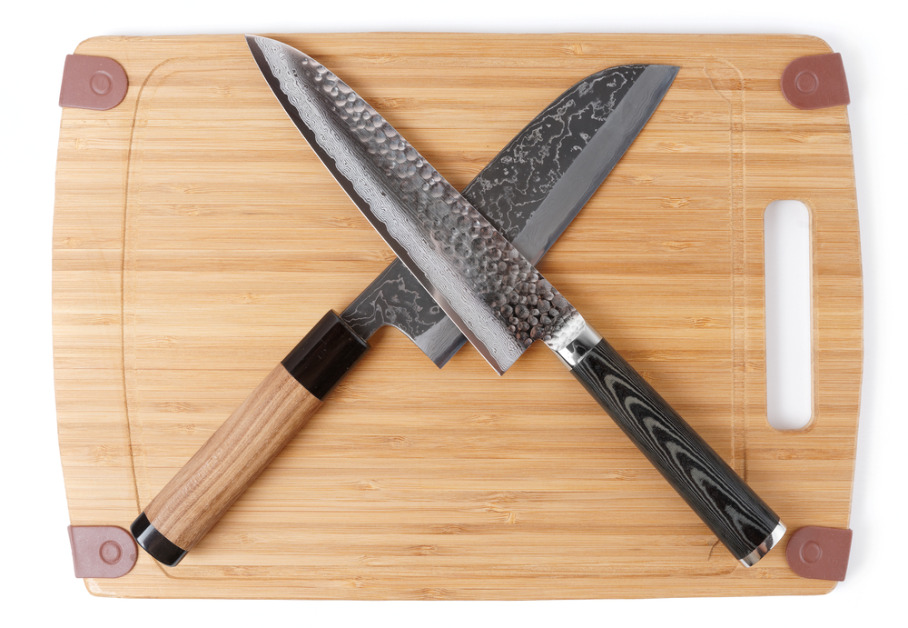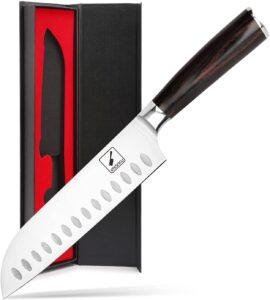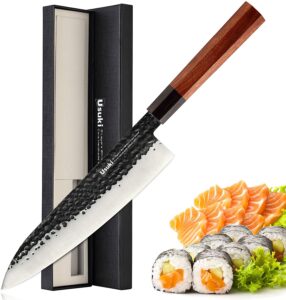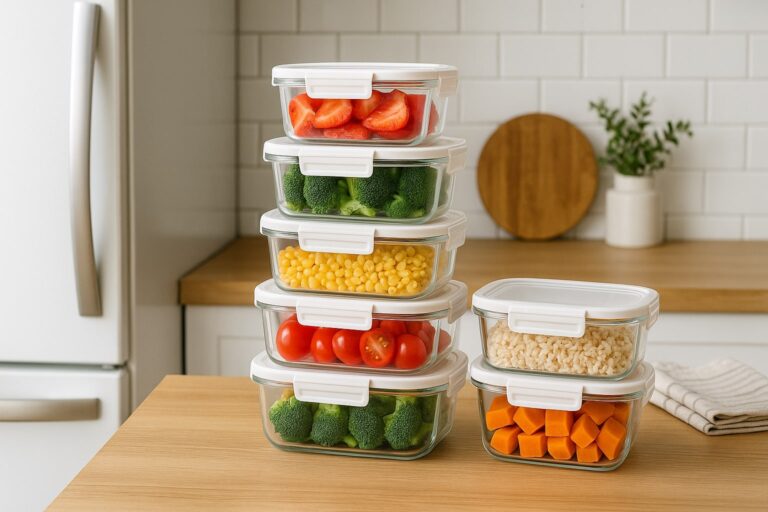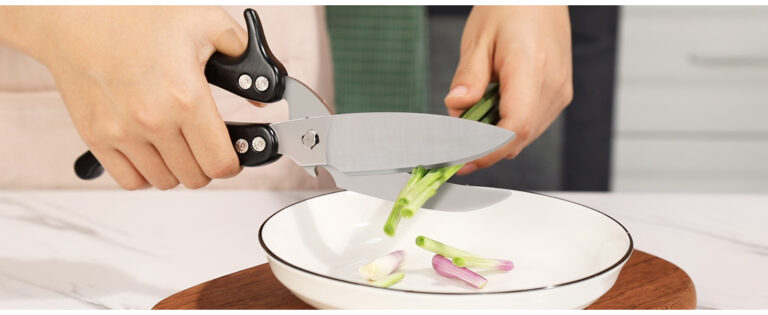When it comes to kitchen knives, there are many options to choose from. Two of the most popular types of knives are Santoku vs Gyuto knives. But what’s the difference between them, and which one should you use? In this blog post, we will discuss the differences between Santoku and Gyuto knives and provide some tips on how to choose the right knife for your needs.
Santoku vs. Gyuto Knives – Major Differences Between Them:
➡️ Corrosion Resistance Ability:
Santoku knives are made of stainless steel, which does not corrode or rust. The blades are also treated with a hardening agent that makes them resistant to chips and scratches. However, since the blades are so thin, they can be damaged if they are mishandled or used for tasks they are not designed for.
Gyuto knives are made of carbon steel, which is less corrosion-resistant than stainless steel. However, because the blade is thicker, it is more resistant to chips and scratches. The downside is that carbon steel requires more maintenance than stainless steel, and it can rust if it is not adequately taken care of. If you are looking for a knife that requires minimal care and maintenance, Santoku is a better choice.
➡️ Blade Design:
The Santoku knife has a pointed tip, making it ideal for carving delicate foods like ham, chicken, or turkey. The Gyuto knife does not have this same pointy tip, making it less suited for carving.
The Santoku knife is shorter in length than the Gyuto knife. When slicing and chopping, this makes it more nimble and manageable. The longer curvature of the Gyuto blade enables you to make more intricate cuts effortlessly.
The Santoku knife is also thinner and sharper than the Gyuto knife, making it less durable. So, if you’re looking for an all-purpose kitchen knife that can do everything, the Gyuto is your best bet.
➡️ Heat Resistance Ability:
When it comes to heat resistance, Santoku knives tend to have better abilities than Gyuto knives. This is because Santoku blades are typically made of harder steel than Gyuto blades. As a result, Santoku knives can withstand higher temperatures without becoming damaged or distorted. So if you’re looking for a knife that can handle heat well, Santoku is the way to go.
But that doesn’t mean Gyuto knives are bad in this category – they can’t quite compare to Santoku knives. If you don’t mind your knife becoming a bit warped when exposed to high temperatures, then a Gyuto knife would be a good choice for you. However, if you want a knife that can withstand heat well, Santoku is a better option.
➡️ Maintenance:
As mentioned before, Santoku knives are much easier to maintain than Gyuto knives. Since the blades are made of stainless steel and treated with a hardening agent, they do not require as much care and maintenance as carbon steel blades. All you need to do is wipe them down after each use, and they will stay corrosion-resistant and look new.
Gyuto knives, on the other hand, require more maintenance than Santoku knives. The carbon steel blades need to be cleaned and oiled regularly to prevent rusting. And since the blades are thicker, they can be challenging to sharpen at home. So if you’re looking for a low-maintenance knife, Santoku is the way to go.
➡️ Edge Retention:
Edge retention refers to how long a knife can maintain its sharpness. Santoku knives typically have better edge retention than Gyuto knives because they are made of harder steel, and Santoku knives can go longer without needing to be sharpened.
Typically, a Japanese chef’s knife is made of a softer steel than other knives. As a result, they don’t maintain their sharpness as long as Santoku knives do. Gyuto knives, on the other hand, are easier to sharpen than Santoku knives. If you’re searching for a knife that doesn’t require frequent sharpening, the Santoku is your best bet.
➡️ Weight and Balance:
The Santoku knife is usually lighter. Santoku knives typically range from 150g to 180g, while Gyuto knives can weigh anywhere from 200g to 240g.
The Santoku knife is also more balanced than the Gyuto knife. Santoku knives have a 50/50 balance between the handle and the blade, making them easier to control when slicing and chopping. Gyuto knives, on the other hand, are unbalanced, and the blade is heavier than the handle, making them more challenging to control.
➡️ Price:
Santoku knives are typically less expensive than Gyuto knives. Santoku knives can range in price from $30 to $130, while Gyuto knives can cost anywhere from $50 to $200.
The reason for this price difference is that Santoku knives are more common than Gyuto knives. Because Santoku knives are so versatile, they have become the standard kitchen knife in Japan. As a result, there is more demand for Santoku knives, which drives up the prices.
But don’t let the lower price tag fool you – Santuko knives are still high-quality Knives. Although they may not be as expensive as Gyuto knives, they are still durable and long-lasting.
While buying a Santoku knife, don’t worry about the price – you’re getting a quality knife that will last you for years to come.
➡️ Usage:
The Santoku knife is primarily a slicing knife, while the Gyuto knife is a multipurpose chef’s knife.
Santoku knives are great for slicing meats, fish, and vegetables, and their curved blade allows them to glide through food without shredding or tearing it smoothly. Santoku knives are also great for dicing onions and other vegetables.
Gyuto knives, on the other hand, can be used for all of the same tasks as Santoku knives, but they can also be used to chop and mince herbs and spices. They have a straighter blade than Santuko knives, which makes them ideal for chopping dense foods like carrots and celery.
➡️ Bevel:
Santoku kitchen knives are single-level, while Gyuto knives are double-level. On the other hand, Double-bevel Santoku knives are becoming more popular nowadays. The single bevel of the Santoku allows chefs and cooks to make immaculate cuts on food that help to keep its flavor, texture, and freshness intact.
The Santoku knife’s asymmetric grind, in addition to its shape, implies a “handedness” to its use; some are better for left-handed users while others are better for right-handed people. The double-bevel Gyuto or double-bevel Santuko knives, on the other hand, do not have a handedness factor and so are simpler to learn.
➡️ Versatility:
Santoku means “three uses” in Japanese, and as the name suggests, Santoku knives are designed to excel at three specific tasks: slicing, dicing, and mincing. Santoku knives can tackle almost any kitchen cutting task, but they shine when it comes to those delicate slicing tasks, such as breaking down a fillet of fish or carving thin slices of meat for sashimi.
The Gyuto, on the other hand, is a Japanese chef’s knife that means “cow sword.” As the name suggests, it was initially designed to be used in butcher shops to break down large pieces of meat, but has since become a staple in Japanese kitchens as an all-purpose chef’s knife.
Santoku and Gyuto knives are equally capable of handling any culinary cutting operation, yet Santoku knives are better for slicing chores while Gyuto knives are better for chopping.
Santoku Knives:
Santoku knives are Japanese-style chef knives explicitly designed to cut meat and fish. Santokus are shorter in length than a standard chef’s knife, with an angled blade that is easy to control. Santoku knives have a pointed tip, making them perfect for carving delicate foods like ham, chicken, or turkey. Santoku knives have a thin edge that can be sharpened to a razor-like finish.
Santoku knives do not work well on dense vegetables such as carrots, potatoes, or onions because they lack the weight and strength of other kitchen knives. Santokus are best used when cutting soft or hard produce like fruits and vegetables (think tomatoes, apples, oranges) and boneless meats. Santoku knives are also much more expensive than Gyuto knives.
Pros:
✅ Very sharp
✅ An Angled blade is easy to control
Cons:
❌ Not suitable for dense vegetables like carrots, potatoes, or onions
❌ More expensive than Gyuto knives
Gyuto Knives:
A Gyuto knife is a Japanese chef’s knife. It is designed to be light and agile, making it perfect for slicing and chopping. The blade is typically made of carbon steel, which makes it sharp and easy to maintain. Compared to the Santoku vs Gyuto, it has a longer blade that curves gently towards the point, allowing you to perform more complex cuts. It is also heavier than a Santoku, making it ideal for tougher cuts of meat or vegetables.
If you are looking for a versatile knife that can handle any task in the kitchen, then a Gyuto is a perfect choice. It is an essential tool for any home cook or professional chef. Whether you are slicing, chopping, or dicing, a Gyuto will make light work of any ingredients. So, if you are in the market for a new knife, be sure to check out a Gyuto. You won’t be disappointed.
Pros:
✅ Light and agile
✅ Sharp and easy to maintain
Cons:
❌ The thicker handle of the Gyuto knife makes it heavier than a Santoku knife.
❌ Because the blades are constructed of a softer material, you’ll need to sharpen them more frequently.
FAQs of Santoku vs Gyuto Knives:
🙋1– How do you sharpen a santoku knife with steel?
📝! Santoku knives are typically sharpened with honing steel. Hold the steel against a hard surface at a 45-degree angle to sharpen your knife using a honing steel. Run the blade of the Santoku Knife down the length of the hone, keeping it in contact with the sharpening ridges on the top of the steel. Repeat this process six to eight times on each side of the blade.
🙋2– How do I choose a Santoku?
📝! Santoku knives are the most accurate knives available, and they’re also referred to as “three virtues” in Japanese. The term “Santoku” was coined to signify how this knife may accomplish three functions with great precision. Santoku Knives are great for slicing, dicing, and mincing vegetables, garlic, and shallots. Santoku knives have a triangular-shaped blade, which is also excellent for chopping greens like cabbage or kale.
When choosing a Santoku knife, consider the size that will be most comfortable for you. Santoku knives range in blade length from just under five inches to almost eight inches. The most popular Santoku knife is seven inches long.
🙋3– Japanese vs. European chef knife, which is better and why?
📝! The Santoku Knife is a Japanese chef’s knife. The Gyuto knife is the most popular and common chef’s knife type in the West. It was created to take the place of a French Gougeres chef’s knife. The Gyuto blade is thinner than the Santoku’s, making it better for cutting meat and vegetables. The Santoku Knife is an all-purpose knife, whereas the Gyuto is better for precise slicing.
Conclusion:
So there you have it – a comparison of Santoku vs. Gyuto knives. As you can see, these two types of knives have their own distinct advantages and disadvantages. So, which one is right for you? Ultimately, the decision comes down to personal preference and your needs in the kitchen. If you want a versatile, all-purpose knife that is easy to maintain, Santoku is the way to go.
But if you are looking for a knife that can handle heat better and has more intricate cutting abilities, Gyuto is a better option. We hope this blog helped you understand the differences between Santoku and Gyuto knives to make an informed decision about which one is right for you. Thanks for reading!

